|
|
|
Sort Order |
|
|
|
Items / Page
|
|
|
|
|
|
|
| Srl | Item |
| 1 |
ID:
099932
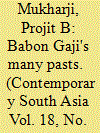

|
|
|
|
|
| Publication |
2010.
|
| Summary/Abstract |
Babon Gaji is a curious god. He is avowedly a Muslim, and the icons that represent him seek to capture his 'Muslim-ness' conspicuously in their attire, not to mention the name itself (Gaji = Ghazi = Muslim warrior-monk) and local lore. Yet he is worshipped by Brahmin Hindu priests who are equally conspicuous in flaunting their Hindu-Brahmin identity. There are no stories about the Gaji ever having been a Hindu or having had anything more than an intellectual interest in Hinduism. He remains, thus, in his afterlife a Muslim; yet, he receives worship through Brahmin priests. Both Hindus and Muslims come to him in large numbers today, in search of a cure for their afflictions. Local accounts place the origins of his shrine at Tajpur, South 24 Parganahs a little over 100 years ago, yet, no account of either the cult or the shrine - to the best of my knowledge - exists in the colonial archive. Neither are there any known written accounts outside the colonial archive that are more than a couple of decades old. For the historian of colonial medicine in the region, therefore, the Gaji presents a difficult challenge.
|
|
|
|
|
|
|
|
|
|
|
|
|
|
|
|
| 2 |
ID:
144075
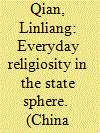

|
|
|
|
|
| Summary/Abstract |
The religious sector in contemporary China is often portrayed as resisting or negotiating with an interventionist state in order to survive or protect its autonomy. This article, however, shows how it enters the state sphere and imbues the presumed state agents. By exploring folk beliefs and practices in a state-run orphanage (such as philanthropists’ activities, which they related to accumulation of karmic merits, childcare workers’ discourses, conduct associated with predestined relationships and baby ghosts, and institution officials’ preoccupation with palmistry, fortune telling and karmic retribution), and the impact of folk belief and practices on the working of the state apparatus, this study aims to enrich current scholarship by looking at state–religion interactions beyond the religious sphere and also reversing the image of Chinese religions as merely passive or reactive actors.
|
|
|
|
|
|
|
|
|
|
|
|
|
|
|
|
| 3 |
ID:
190120
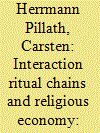

|
|
|
|
|
| Summary/Abstract |
This paper explores the theory of ‘interaction ritual chains’ proposed by the sociologist Randall Collins in understanding popular religion in China today. It contributes to ongoing conceptual debates over approaching Chinese religions and draws conclusions for general socio-economic theory. We concentrate on the specific phenomenon of the resurgence of ancestor worship and lineage rituals which we have explored in fieldwork done in Shenzhen metropolis. We study two empirical cases, the re-emergence of ritual spaces that project the ritual infrastructure of the traditional village onto the modern urban infrastructure, and the role of the internet in mediating ritual activities between the local and the global.
|
|
|
|
|
|
|
|
|
|
|
|
|
|
|
|
| 4 |
ID:
079929
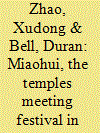

|
|
|
|
|
| Publication |
2007.
|
| Summary/Abstract |
We examine the multiple purposes and modalities that converge during a circuit of festivals, miaohui, which temples organize in recognition of local gods and which are attended reciprocally by temple representatives from the surrounding area in North China. The festivals involve intense expressions of devotion to one or more deities, while offering an opportunity for representatives of other villages to seek recognition through rather boisterous drumming and prolonged choreographed dancing. We note also the emergence of Mao as a great god whose legacy as Chairman of the CCP is projected in order to legitimate current Party leadership and their policy of reform while concurrently acting as a powerful denial of those same policies from the perspective of villagers.
|
|
|
|
|
|
|
|
|
|
|
|
|
|
|
|
| 5 |
ID:
188579
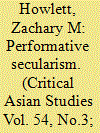

|
|
|
|
|
| Summary/Abstract |
This article examines the role of religion in China’s National College Entrance Exam, the Gaokao. In Chinese schools, religion is officially banned and branded superstition. But some Gaokao-preparatory high schools sponsor pilgrimages to pray for exam success, invite ritualists to exorcize ghosts, and tolerate discussions of karmic merit, euphemistically termed “character” (renpin). Based on two years of ethnographic fieldwork in rural and urban schools in Fujian Province, this article argues that such practices help people maintain self-efficacy while revealing secularism to be a performance. Hypercompetition in the post-Mao era (1977–present) has created a perceived disconnect between effort and reward, and to restore that balance, people appeal to local gods and cosmic reciprocity. But elites must pay deference to secular ideals while quietly pursuing local practices in what sociologist Erving Goffman terms the backstage. Such Janus-faced obeisance has analogs in the imperial era. By analyzing secularism as a performance with early modern genealogies, this article advances understanding of Chinese regime legitimacy, adds to ethnographies of secularism’s lived experience in Asia, and helps to account for why popular religion continues to flourish despite more than a century of suppression.
|
|
|
|
|
|
|
|
|
|
|
|
|
|
|
|
| 6 |
ID:
115725


|
|
|
|
|
| Publication |
2012.
|
| Summary/Abstract |
Over the past three decades, rural China has seen a resurgence of ritual and religious practices involving lineage halls, temples, and novel sectarian movements. This revival of rituals is well documented in ethnographic literature, and a case in point is the establishment of a temple for a local dragon deity in the Hebei township of Fanzhuang. Descriptions of this particular revival focus on a score of males involved in the practical organization of the annual temple fair, while largely ignoring the contributions of a group of spirit mediums and middle-aged women attending rituals in private homes and neighbouring villages throughout the year. The locals often compare the gendered division of labour evident in the temple to households where men are said to be responsible for external matters while women take care of internal affairs. Based on 10 months of ethnographic fieldwork, the article argues that religious practices in both temples and households evince a gendered division of labour: men take charge of the public exterior and relations with the authorities and women see to the private interior and relations with deities. The ongoing revival of rituals is thus gendered in such a way that the significant role of women tends to be hidden from public view.
|
|
|
|
|
|
|
|
|
|
|
|
|
|
|
|
| 7 |
ID:
113278
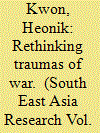

|
|
|
|
|
| Publication |
2012.
|
| Summary/Abstract |
The experience of the Vietnam War provoked, first in the USA and later more broadly, strong clinical and public interest in invisible, psychological war wounds. In post-war Vietnam, however, the traumas of war had quite different meanings. At grass-roots level, these were focused on the sufferings endured by the human soul after tragic or violent death. This article explores the idea that memories of the violent past may captivate and continue to torment the spirits of the dead.
|
|
|
|
|
|
|
|
|
|
|
|
|
|
|
|
| 8 |
ID:
183488
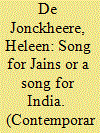

|
|
|
|
|
| Summary/Abstract |
This research note studies the interaction of religiosity and national sentiment on the popular level of Jainism in dealing with the COVID-19 crisis. It does so through a case study of a Jain popular song, which was created as a response to the everyday impact of the COVID-19 virus in India. The article will analyse the song's YouTube video, its lyrics, reception and social media adaptation, to illustrate how the Jain religious interpretation of a health crisis intersects with national discourse. It will also illuminate how such popularising interpretation, through its afterlife, was co-opted within a narrative of national culture.
|
|
|
|
|
|
|
|
|
|
|
|
|
|
|
|
|
|
|
|
|